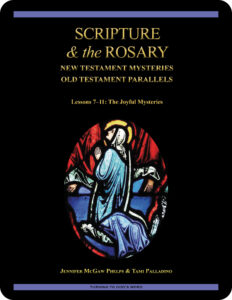 Scripture & the Rosary:
Scripture & the Rosary:
New Testament Mysteries,
Old Testament Parallels
The Fifth Joyful Mystery
Lesson 11 All Who Heard Him Were Amazed
the Gospel According to Luke 2:41–52
the First Book of Samuel 3:1–9
Revised Standard Version Catholic Edition (RSVCE)*
New American Bible Revised Edition (NABRE)*
Catechism of the Catholic Church
Rosarium Virginis Mariae (Rosary of the Virgin Mary)
ex libris (in our library)
cross references for Scripture & the Rosary
glossary for Scripture & the Rosary
next lesson: He Began to Be Sorrowful
This material coordinates with Lesson 11 on pages 40–43 in Scripture & the Rosary: New Testament Mysteries, Old Testament Parallels.
And Mary said, “My soul magnifies the Lord, and my spirit rejoices in God my Savior,
for he has regarded the low estate of his handmaiden.
For behold, henceforth all generations will call me blessed;
for he who is mighty has done great things for me, and holy is his name.”
—the Gospel According to Luke 1:46–49
welcome to our in-depth study of Scripture & the Rosary
We invite groups and individuals to become acquainted with Turning to God’s Word Catholic Bible  studies through
studies through  Scripture & the Rosary: New Testament Mysteries, Old Testament Parallels, which has been granted an imprimatur. Although no longer available in print, the first six lessons can be downloaded from our website. The remaining 20 lessons are posted throughout the liturgical year along with their related online study pages. Click here to access Lesson 7 through Lesson 11. If you have a Bible-related question or comment, you can contact our authors using one of the “ask us your question” or “what do you think” buttons on any online study page.
Scripture & the Rosary: New Testament Mysteries, Old Testament Parallels, which has been granted an imprimatur. Although no longer available in print, the first six lessons can be downloaded from our website. The remaining 20 lessons are posted throughout the liturgical year along with their related online study pages. Click here to access Lesson 7 through Lesson 11. If you have a Bible-related question or comment, you can contact our authors using one of the “ask us your question” or “what do you think” buttons on any online study page.
open with prayer
It’s always wise to begin any Bible study with prayer, whether reading the Scriptures alone or meeting with others in a discussion group. You can pray using your own words or use one of the opening prayers on our website. We especially like the following:
Lord Jesus, you promised to send your Holy Spirit to teach us all things.
As we read and study your word today,
allow it to touch our hearts and change our lives. Amen.
making connections—two experiences of discovering God
In this lesson, the Old Testament parallel to Finding Jesus in the Temple is God’s call to Samuel. Both the Old and New Testament passages deal with the close relationship God establishes with young 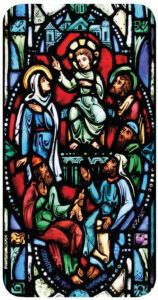 people. What is the earliest recollection you have of an awareness of God’s love? Clicking on the New and Old Testament stained glass windows will enlarge the art. The same art also illustrates Lesson 11 in Scripture & the Rosary: New Testament Mysteries, Old Testament Parallels. You can learn more about
people. What is the earliest recollection you have of an awareness of God’s love? Clicking on the New and Old Testament stained glass windows will enlarge the art. The same art also illustrates Lesson 11 in Scripture & the Rosary: New Testament Mysteries, Old Testament Parallels. You can learn more about  Samuel’s early life and his call to become a prophet in Lesson 1 The LORD Announces He Is About to Do a New Thing in the Turning to God’s Word Catholic Bible
Samuel’s early life and his call to become a prophet in Lesson 1 The LORD Announces He Is About to Do a New Thing in the Turning to God’s Word Catholic Bible  study Thus Says the LORD: God Speaks Through His Servants the Prophets—Volume I: A Kingdom Divided. Samuel’s adult life is covered in The United Kingdom: Saul, David & Solomon Foreshadow Christ the King.
study Thus Says the LORD: God Speaks Through His Servants the Prophets—Volume I: A Kingdom Divided. Samuel’s adult life is covered in The United Kingdom: Saul, David & Solomon Foreshadow Christ the King.
let’s look at the new in the light of the old
As you read through this lesson’s selected passages from the New and Old Testaments, ask yourself what these two biblical accounts have in common. Additional in-depth questions can be found on pages 40–43 in Scripture & the Rosary: New Testament Mysteries, Old Testament Parallels.
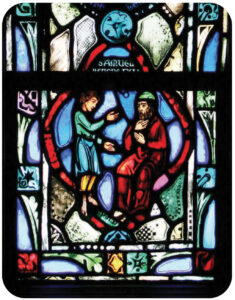 ? What is similar about Jesus’ experience in the Temple at Jerusalem and Samuel’s experience sleeping near the ark of God at Shiloh?
? What is similar about Jesus’ experience in the Temple at Jerusalem and Samuel’s experience sleeping near the ark of God at Shiloh?
? How do these two biblical accounts differ?
? Who is in control of the events in Jerusalem?
? Who is in control of the events in Shiloh?
? What might explain why Finding Jesus in the Temple is included as one of the Joyful Mysteries of the Rosary?
? Look at the pictures of the stained glass window panels on pages 40 and 42 in Scripture & the Rosary: New Testament Mysteries, Old Testament Parallels. What similarities do you see between these depictions of the New and Old Testament scenes?
supplemental Scripture
The New Testament text is taken from the Gospel According to Luke 2:41–52, and it includes the only  biblical information about Jesus’ childhood. The Old Testament parallel is the story of Samuel’s call by God. The First Book of Samuel 3:1–18 covers the essential details of Samuel’s call as well as Eli’s response. Additional information about Samuel’s anointing of the first two kings of Israel—Saul and David—can be found in the First Book of Samuel 3:19—16:13.
biblical information about Jesus’ childhood. The Old Testament parallel is the story of Samuel’s call by God. The First Book of Samuel 3:1–18 covers the essential details of Samuel’s call as well as Eli’s response. Additional information about Samuel’s anointing of the first two kings of Israel—Saul and David—can be found in the First Book of Samuel 3:19—16:13.
ex libris—a book that examines Jesus’ understanding of his role as Son of God
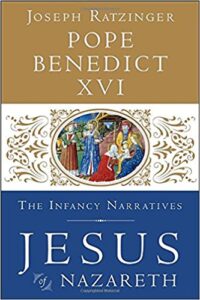
 Jesus of Nazareth: The Infancy Narratives is the last book in a three-part series about Jesus in the Gospels by Pope Benedict XVI. Focusing on Scripture, this relatively short work examines the infancy narratives found in the Gospels According to Matthew and Luke, and when relevant looks at the Gospel According to John. Read excerpts and learn more about the Jesus of Nazareth trilogy and other works related to Bible study at ex libris—main bookshelf.
Jesus of Nazareth: The Infancy Narratives is the last book in a three-part series about Jesus in the Gospels by Pope Benedict XVI. Focusing on Scripture, this relatively short work examines the infancy narratives found in the Gospels According to Matthew and Luke, and when relevant looks at the Gospel According to John. Read excerpts and learn more about the Jesus of Nazareth trilogy and other works related to Bible study at ex libris—main bookshelf.
“Jesus’ reply to his mother’s question is astounding: How so? You were looking for me? Did you not know where a child must be? That he must be in his father’s house, literally ‘in the  things of the Father [the Gospel According to Luke 2:49].’ Jesus tells his parents: I am in the very place where I belong—with the Father, in his house.
things of the Father [the Gospel According to Luke 2:49].’ Jesus tells his parents: I am in the very place where I belong—with the Father, in his house.
“… The Son, the child, must be with his father. … He must suffer greatly, be rejected, be killed, and rise again, as he says to his disciples after Peter’s confession [the Gospel According to Mark 8:31]. He is already bound by the ‘must’ at this early hour: he must be with the Father, and so it becomes clear that what might seem like disobedience or inappropriate freedom vis-a-vis his parents is in reality the actual expression of his filial obedience. He is in the Temple not as a rebel against his parents, but precisely as the obedient one, acting out the same obedience that leads to the Cross and the resurrection.”
read the Catechism—how well do you know your faith?
Do you have a firm grasp about how the Mysteries of the Rosary can help Christians persevere in faith? In what way does praying about the Fifth Mystery of  the Rosary help you to relate to Jesus? Consider whether you might find it easier to relate to Jesus’ earthly parents, the Blessed Virgin Mary and St. Joseph? What do you understand as Jesus’ mission, and how do you think that it relates to your own life?
the Rosary help you to relate to Jesus? Consider whether you might find it easier to relate to Jesus’ earthly parents, the Blessed Virgin Mary and St. Joseph? What do you understand as Jesus’ mission, and how do you think that it relates to your own life?
What might explain why Jesus being found in the temple is the event at the heart of the fifth Mystery of the Rosary? To learn what the Church teaches, refer to paragraph 534 in the Catechism of the Catholic Church.
WHAT DO YOU THINK about recognizing the presence of God?
The call of God can occur at any time and in any place, making it impossible to plan for or to predict.
 ? How do you think it is that Eli was able to understand that God was calling Samuel?
? How do you think it is that Eli was able to understand that God was calling Samuel?
? What about Samuel’s situation suggests that he might have been open to God’s call?
? What is out of the ordinary about Samuel’s experience?
? Has God ever surprised you by initiating an out-of-the-ordinary encounter?
? Are you open to the idea of being called by God? Why or why not?
? What’s one step that you can take to be more open to hearing God’s voice?
? Why do you think it is that the Blessed Virgin Mary and Joseph fail to understand what Jesus is saying to them about being in his Father’s house?
? What obstacles might exist that could have hampered their understanding?
? What obstacles might exist in your life that could be preventing you from hearing and understanding what God is saying to you?
WHAT DO YOU THINK about trying to avoid God?
We can contrast the story about the Blessed Virgin Mary and Joseph finding Jesus in the Temple at Jerusalem with the  story of Adam and Eve hiding from God in the Garden of Eden. This marks a decided change from the nature of humanity’s relationship with God in the Old Testament. You can learn more about the impact of original sin in Lesson 3 The Fall of Adam & Eve in the Turning to God’s Word Catholic Bible study In the Beginning: The Book of Genesis.
story of Adam and Eve hiding from God in the Garden of Eden. This marks a decided change from the nature of humanity’s relationship with God in the Old Testament. You can learn more about the impact of original sin in Lesson 3 The Fall of Adam & Eve in the Turning to God’s Word Catholic Bible study In the Beginning: The Book of Genesis.
? What’s happened to bring about this change in the way that humanity and God interact?
? Consider a time in the past when you may have wished that you could hide from God. What was going on in your life then?
 ? How has that situation changed?
? How has that situation changed?
? What did you do to change it?
? What did God do to change it?
? If the situation hasn’t changed, what might explain why not?
? What change might God be waiting for you to make?
 favor with God—you could look it up in our archives
favor with God—you could look it up in our archives
Scripture shows both Jesus and Samuel finding favor with God. What do they do that pleases God? What can you do to please God? To learn more about favor with God, read Lost in Translation, an online column in which Turning to God’s Word author Matthew Phelps helps readers connect with ideas expressed in the original languages of the Scriptures. New Lost in Translation entries are posted on Mondays, and past entries are archived on our website. Contact us if you’d like to receive Lost in Translation by email every week.
do you know the spiritual fruit associated with the Fifth Joyful Mystery?
Hint: To avoid some negative connotations, present-day Christians sometimes refer to this fruit as piety. You can find out what it is in the “Fruits of Prayer” box on page 41 in Scripture & the Rosary: New Testament Mysteries, Old Testament Parallels. In what ways might this fruit be of benefit to you?
the best Catholic commentary about Scripture
 To find out more about how Church teaching is supported by passages in Scripture & the Rosary: New Testament Mysteries, Old Testament Parallels, check out the Index of Citations in the Catechism of the Catholic Church. Links to the primary Scripture passages in the lesson (Revised Standard Version Catholic Edition [RSVCE*]) and relevant paragraphs in the Catechism are provided here. Not every passage in the biblical text for this study is referenced in a Catechism paragraph, however.
To find out more about how Church teaching is supported by passages in Scripture & the Rosary: New Testament Mysteries, Old Testament Parallels, check out the Index of Citations in the Catechism of the Catholic Church. Links to the primary Scripture passages in the lesson (Revised Standard Version Catholic Edition [RSVCE*]) and relevant paragraphs in the Catechism are provided here. Not every passage in the biblical text for this study is referenced in a Catechism paragraph, however.
the Gospel According to Luke 2:41—paragraph 583
the Gospel According to Luke 2:41–52—paragraph 534
the Gospel According to Luke 2:48–49—paragraph 503
the Gospel According to Luke 2:49—paragraph 2599
the Gospel According to Luke 2:51—paragraphs 517, 2196, 2599
the Gospel According to Luke 2:52—paragraph 472
the First Book of Samuel 3:9–10—paragraph 2578
ways our glossary might prove helpful
In addition to providing extra information about geographical locations, our glossary also points out  when a person or place is mentioned in the biblical text under more than one name or more than one spelling. If you can remember a name but aren’t sure in which lesson it shows up, you can find it in the glossary, which lists every proper noun that appears in the primary biblical text in Scripture & the Rosary: New Testament Mysteries, Old Testament Parallels.
when a person or place is mentioned in the biblical text under more than one name or more than one spelling. If you can remember a name but aren’t sure in which lesson it shows up, you can find it in the glossary, which lists every proper noun that appears in the primary biblical text in Scripture & the Rosary: New Testament Mysteries, Old Testament Parallels.
to learn more, read more Scripture
When you’re having difficulty understanding a passage of Scripture, it can help to read the  cross references—but looking these up takes time. We’ve compiled the cross references from the Revised Standard Version Second Catholic Edition (RSV2CE)—the same translation that we reprint in our study books. The list can be found at the top of every online study page, and it includes links to cross references in the primary biblical texts for all of the lessons in Scripture & the Rosary: New Testament Mysteries, Old Testament Parallels.
cross references—but looking these up takes time. We’ve compiled the cross references from the Revised Standard Version Second Catholic Edition (RSV2CE)—the same translation that we reprint in our study books. The list can be found at the top of every online study page, and it includes links to cross references in the primary biblical texts for all of the lessons in Scripture & the Rosary: New Testament Mysteries, Old Testament Parallels.
don’t forget about our indexes & extra online material

 If you’re trying to locate information about a Scripture passage, you can look it up in the index at the back of the online version of this study. If you want to revisit a commentary, you can look it up by title in the topics index. If you want to learn more about another book of the Bible for which there’s a Turning to God’s Word study, you can read online commentaries and watch any accompanying videos by choosing a lesson from one of the study directories. (There are no lesson videos with Scripture & the Rosary: New Testament Mysteries, Old Testament Parallels.) Finally, if you have a question or would like to make a comment about any of our studies, you can use the “ask us your question” or “what do you think” button to email our authors.
If you’re trying to locate information about a Scripture passage, you can look it up in the index at the back of the online version of this study. If you want to revisit a commentary, you can look it up by title in the topics index. If you want to learn more about another book of the Bible for which there’s a Turning to God’s Word study, you can read online commentaries and watch any accompanying videos by choosing a lesson from one of the study directories. (There are no lesson videos with Scripture & the Rosary: New Testament Mysteries, Old Testament Parallels.) Finally, if you have a question or would like to make a comment about any of our studies, you can use the “ask us your question” or “what do you think” button to email our authors.
ex libris—Church documents & books about religious topics
Link to magisterial documents referred to in our Bible studies at ex libris—magisterial documents.  This listing includes significant recent encyclicals as well as a number of historical Church documents. Recommended books related to Scripture study can be found at ex libris—main bookshelf.
This listing includes significant recent encyclicals as well as a number of historical Church documents. Recommended books related to Scripture study can be found at ex libris—main bookshelf.
wondering how to pronounce some of these words?
The following links are to readings from the New International Version (NIV) Bible. To listen, click on the audio icon above the printed text. Although not taken from the translations used in our study materials, the NIV readings provide an audio guide to pronunciation of words in this lesson’s primary biblical texts. A close online version of the translation of the Bible used in Catholic liturgy in the United States as well as an audio guide for daily Mass readings for the current month can be found on the website of the United States Conference of Catholic Bishops (USCCB).
the Gospel According to Luke 2:41–52 (NIV)
the First Book of Samuel 3:1–9 (NIV)
close by praying the Fifth Joyful Mystery
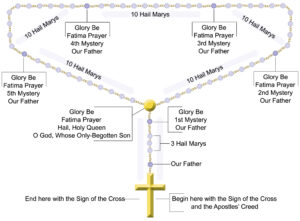 Many of our study groups like to conclude discussions of Scripture & the Rosary: New Testament Mysteries, Old Testament Parallels by praying a decade of the Rosary devoted to the Mystery that’s the focus of their lesson. A number of Catholics include a request for an increase in the spiritual fruit associated with the mystery. You can find out what’s associated with the Fifth Joyful Mystery in the “Fruits of Prayer” box on page 41 in Scripture & the Rosary: New Testament Mysteries, Old Testament Parallels.
Many of our study groups like to conclude discussions of Scripture & the Rosary: New Testament Mysteries, Old Testament Parallels by praying a decade of the Rosary devoted to the Mystery that’s the focus of their lesson. A number of Catholics include a request for an increase in the spiritual fruit associated with the mystery. You can find out what’s associated with the Fifth Joyful Mystery in the “Fruits of Prayer” box on page 41 in Scripture & the Rosary: New Testament Mysteries, Old Testament Parallels.
 We invite you to pray along with Turning to God’s Word co-founder Tami Palladino and her daughter Anne Marie on their prayer video featuring the Fifth Joyful Mystery of the Rosary. The prayers and videos for all 20 mysteries are accessible year-round at how to pray the Rosary, and you can access a link to Tami and Anne Marie’s how-to video to learn what’s important about praying the Rosary. Clicking on the diagram (above) will take you to the website page with the Rosary prayers.
We invite you to pray along with Turning to God’s Word co-founder Tami Palladino and her daughter Anne Marie on their prayer video featuring the Fifth Joyful Mystery of the Rosary. The prayers and videos for all 20 mysteries are accessible year-round at how to pray the Rosary, and you can access a link to Tami and Anne Marie’s how-to video to learn what’s important about praying the Rosary. Clicking on the diagram (above) will take you to the website page with the Rosary prayers.
Lesson 12 He Began to Be Sorrowful (the First Sorrowful Mystery, the Agony in the Garden)—the Gospel According to Matthew 26:36–46, the Second Book of Samuel 15:13–16, and the Second Book of Samuel 15:19–23
Lesson 10 A Light for Revelation to the Gentiles (the Fourth Joyful Mystery, the Presentation in the Temple)—the Gospel According to Luke 2:22–35 and the First Book of Samuel 1:24–28
you also may like our two-part study of the prophets
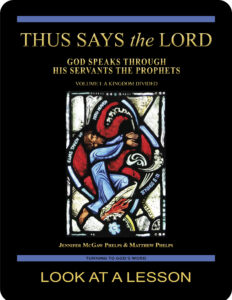
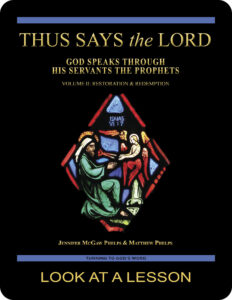 Thus Says the LORD: God Speaks Through His Servants the Prophets—Volume I: A Kingdom Divided examines the prophets in their historical context using the First and Second Books of the Kings and other Old Testament passages written before the Babylonian Exile in 586 B.C. Volume II: Restoration & Redemption looks at the post-exilic prophets. This 51-lesson Catholic Bible study builds on The United Kingdom of Israel: Saul, David & Solomon Foreshadow Christ the King. Click on the books’ covers to view a sample lesson from each volume.
Thus Says the LORD: God Speaks Through His Servants the Prophets—Volume I: A Kingdom Divided examines the prophets in their historical context using the First and Second Books of the Kings and other Old Testament passages written before the Babylonian Exile in 586 B.C. Volume II: Restoration & Redemption looks at the post-exilic prophets. This 51-lesson Catholic Bible study builds on The United Kingdom of Israel: Saul, David & Solomon Foreshadow Christ the King. Click on the books’ covers to view a sample lesson from each volume.
start a Turning to God’s Word Bible study
Thank you for your interest in Scripture & the Rosary: New Testament Mysteries, Old Testament Parallels. 
 Information about beginning a Turning to God’s Word Bible study can be found at start a Bible study. Tami, Matthew, and I are available to answer your questions and to offer support. You may use this email to contact us directly if you’re interested in starting a Turning to God study or in having your study schedule listed with other TtGW study groups on our website. —Jennifer
Information about beginning a Turning to God’s Word Bible study can be found at start a Bible study. Tami, Matthew, and I are available to answer your questions and to offer support. You may use this email to contact us directly if you’re interested in starting a Turning to God study or in having your study schedule listed with other TtGW study groups on our website. —Jennifer
*There are seven deuterocanonical books in the Old Testament—the Books of Tobit, Judith, Wisdom, Sirach, Baruch, and First and Second Maccabees, as well as some passages in the Books of Esther and Daniel. Protestants usually refer to these works as “apocryphal,” a word that means “outside the (Protestant) canon” because they’re excluded from most Protestant Bibles. The word “deuterocanonical” means “second canon”; Catholics use that word to refer to any section of the Catholic Old Testament for which there are no extant, or existing, Hebrew manuscripts. All of the deuterocanonical books appear in the Septuagint, the earliest remaining versions of which date to the 1st century B.C. This Greek translation of the Old Testament was in common use by Jews at the time of Jesus. Learn more by reading How Do Catholic & Protestant Bibles Differ?
Turning to God’s Word printed Bible studies use the 2006 Revised Standard Version Second Catholic Edition (RSV2CE) translation for all Scripture references except those to the Psalms, which are taken from The Abbey Psalms and Canticles, prepared by the Benedictine monks of Conception Abbey and published in 2020 by the United States Conference of Catholic Bishops (USCCB). All Scripture links for the digital version of Scripture & the Rosary: New Testament Mysteries, Old Testament Parallels are to the 1966 Revised Standard Version Catholic Edition (RSVCE) translation. The New International Version (NIV) audio recordings follow the same chapter and verse numbering as the RSV Catholic translations, but the NIV translation doesn’t include the deuterocanonical books and passages.
The 1966 RSVCE uses archaic pronouns and verb forms such as “thee,” “thou,” “didst” in the Psalms and in direct quotations attributed to God. The 2006 RSV2CE replaces these with more accessible English. The few significant translation changes in the RSV2CE include rendering almah as “virgin” in the Book of Isaiah 7:14 and restoring the term “begotten” in the Gospel According to John 3:16.
Numbering varies for some passages in this Bible study. Turning to God’s Word studies follow the numbering in the Revised Standard Version Catholic translations (RSV2CE and RSVCE). Discrepancies in the New American Bible Revised Edition (NABRE) are noted in the Index of Scripture Citations.
 You can learn more about the Psalms by viewing a sample lesson from the Turning to God’s Word Catholic Bible study Sing a New Psalm: Communicating with God Through the Prayers of the Church—Volume I: Lauds & Vespers. The second part of that study, Sing a New Psalm: Communicating with God Through the Prayers of the Church—Volume II: Vigils, Day Prayer & Compline, is scheduled for publication in 2025. Some verse numbers may vary in different translations of the Psalms.
You can learn more about the Psalms by viewing a sample lesson from the Turning to God’s Word Catholic Bible study Sing a New Psalm: Communicating with God Through the Prayers of the Church—Volume I: Lauds & Vespers. The second part of that study, Sing a New Psalm: Communicating with God Through the Prayers of the Church—Volume II: Vigils, Day Prayer & Compline, is scheduled for publication in 2025. Some verse numbers may vary in different translations of the Psalms.
